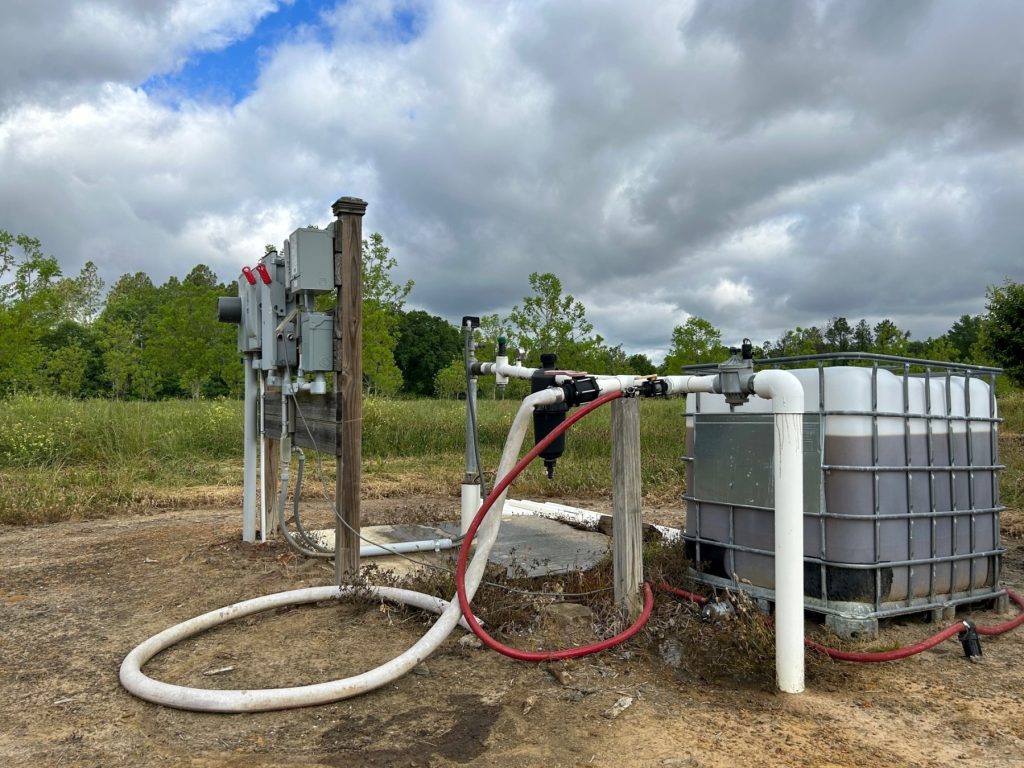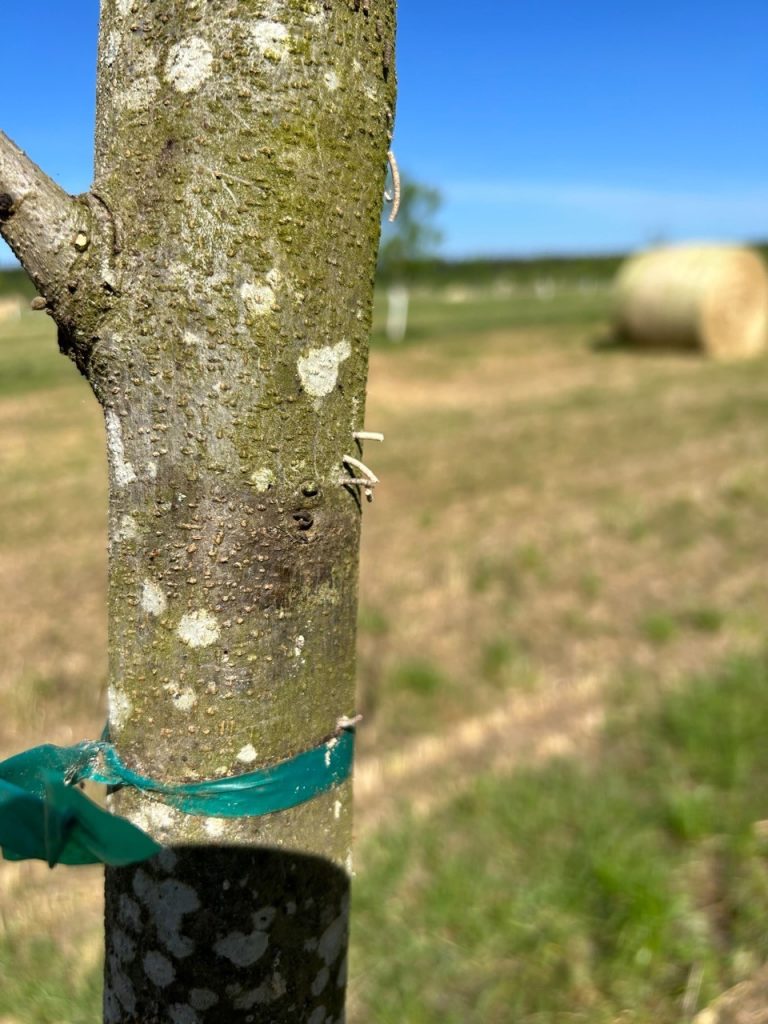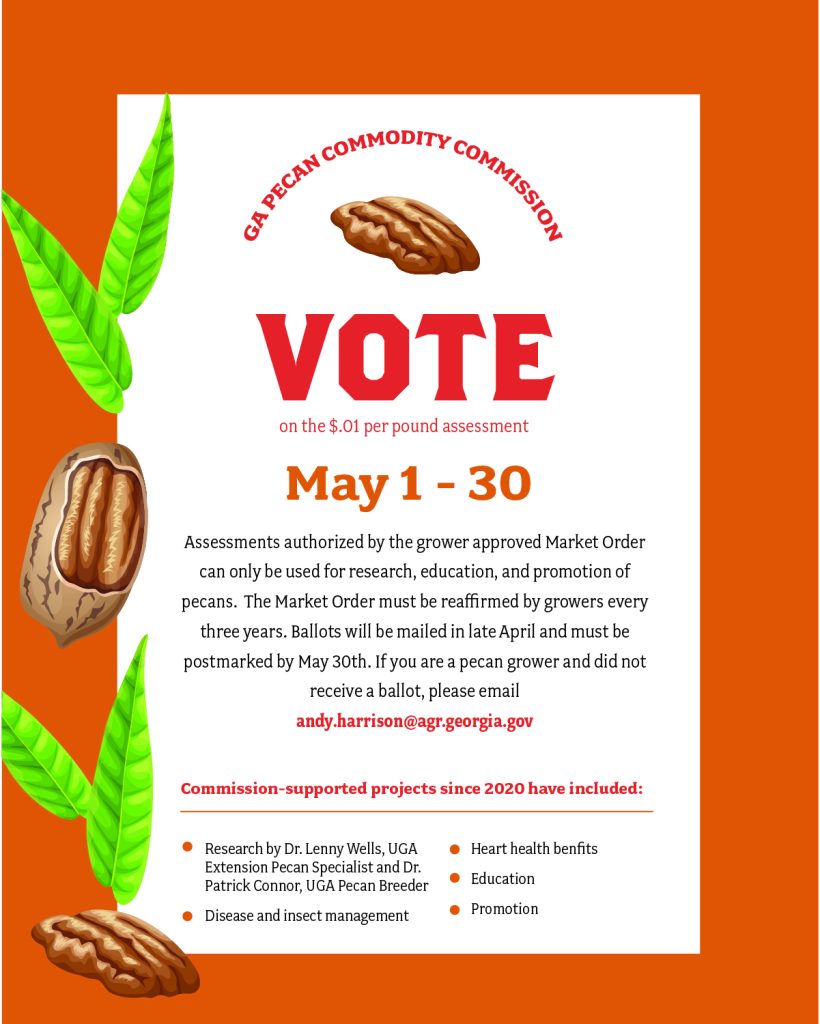N-Fertilizer Injection
We are in the middle of fertilization season again and many are choosing to inject their N through the irrigation system. This is a great way to fertilize pecan trees with N. It’s cheaper and allows you to spoon feed them a little at the time through the season. The trees respond well to this method of fertilization and you don’t lose as much N when applied this way. In reference to my point about being cheaper—its cheaper and more efficient only if you are applying your N based on the treated area. When I was getting prices a month ago, dry urea was $0.55/unit and 28% liquid UAN was $0.79 per unit. But when you inject through a microsprinkler system you are covering only a small fraction of the orchard.

As an example, if you have a 100 acre orchard spaced 40 X 40 (27 trees per acre) that’s 2700 trees total. If you have a 360 degree microsprinkler tip that sprays a circle 19′ in diameter, you figure the area of that circle and multiply by the 2700 trees in the orchard:
A=3.14(r2)—–(I can’t find the symbol for pi on the keyboard through the program in which I’m writing this)
r=19/2 = 9.5
9.52 = 90.25
A=3.14(90.25)= 283 square feet
283 X 2700 = 765,139.5 square feet total
765,138.5/43,560 = 17.5 acres
So in our example, if you are injecting 25 units of N/acre at the time on 17.5 acres, that’s 437.5 units of N X $0.79/unit = $345.63 total per injection.
Let’s say you do a total per year of 125 units/acre, so at 5 injections over the course of the year, that’s a total of $1728.15 spent on N fertilizer.
A lot of people figure the entire orchard area when they are injecting and thus over-estimate and over-apply what they actually need. Your fertilizer dealer will like this but its not helping your pocketbook or your production. If you compare our example above with injecting based on total orchard area, you are looking at 25 units N/acre X 100 acres per injection, 2500 units total X $0.79 per unit = $1975 per injection X 5 injections = $9875 spent on N fertilizer. That’s a big difference and the results on the tree will be the same as if you figured on 17.5 acres.
The exact numbers for drip may vary and depend on the spreading pattern in various soils as well as the number and volumes of emitters per tree but the formula above for microsprinkler could serve as a rough estimate.
If you are applying dry urea at $0.55/unit to the entire 100 acres, that’s $0.55X 125 units = $68.75 X 100 = $6875 spent on N fertilizer. If you only apply that to your herbicide strip, which covers about 30% of the orchard floor, that’s $2062.50 spent on N fertilizer. Again, a big difference with the same results on tree N and yield.
Be On the Lookout For Ambrosia Beetle

Over the last week there have been a number of calls on ambrosia beetles. As temperatures continue to warm up there is potential to see more activity so be on the lookout for these pests on young plantings (1-3 years old) especially. A pyrethroid spray every 7-10 days remains the best method of managing this pest where problems occur.
Georgia Agricultural Commodity Commission for Pecans Referendum

The Georgia Agricultural Commodity Commission for Pecans is up for a vote this year. Ballots will be going out soon and should be mailed back by May 30. We have so many different pecan organizations between the GPGA, GACCP, APC, NPF, and ABBP, and a few assessments involved with some of these organizations, I wanted to clarify exactly what the Georgia Ag Commodity Commission for Pecans (GACCP) does for you as growers.
The GACCP is where your $0.01 assessment goes to promote GEORGIA pecans. The APC and APPB promote pecans nationally and are funded by your $0.03 assessment to promote American Pecans both domestically and internationally.
The $0.01 GACCP assessment for promotion of GEORGIA pecans funds several projects that push our Georgia grown pecans on domestic and international markets. It is the only group actively working with funding specifically for the promotion of Georgia pecans and makes efforts to set Georgia-grown pecans apart from nuts grown elsewhere.
In addition to these promotion efforts, your GACCP assessment helps fund a large amount of the research that scientists like myself and others at UGA and USDA conduct. This includes fertilization and irrigation research, hedge-pruning studies, new pecan cultivar development, scab research, research on insect pest management, the health benefits of pecans, etc.
You may not realize that your assessment dollars also provide much of the funding for key positions like that of Andrew Sawyer, SE Distsrict Area Pecan Agent, as well as the funding for such fundamental things as the fuel required for extension specialists like myself, Dr. Apurba Barman, and Andrew Sawyer to make visits to your orchards.
We thank you for all the funding of the GACCP over the last 28 years and hope that you see enough value in the efforts of the GACCP to vote yes on the GACCP referendum in the coming month. The Georgia pecan industry has come a long way since 1995 and it has all been done through the assessments paid by growers.
